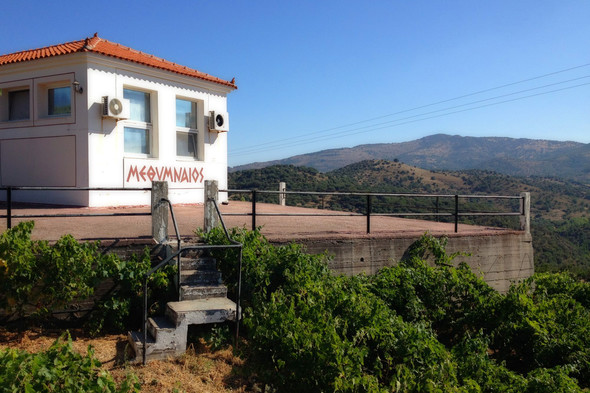The island of Lesbos is known for a variety of reasons, although, wine has never been one of them. While guidebooks frequently mention Lesbos for its extraordinarily rich cultural heritage (and the ouzo), nowadays, the island is in the media spotlight due to the army of refugees swarming over from Turkish shores. Though, no doubt, Lesbos also deserves the attention of the international wine market, for it produces some exceptional wines with intriguing stories behind them.
There are two well-known wineries on the island. The first is Oinoforos, which is located near Mitilini, the capital city of Lesbos. They make wines out of less well-known, local grapes and keep their prices fairly low, so if you fancy, you can pick up a bottle in any supermarket on the island for around €6-10. The other mayor winery is Dr Yannis Lambrou’s winery, which stretches across the north-western part of Lesbos, in Chidira, a tiny secluded village amid bare mountains. Yannis followed in his parents’ footsteps and became a winemaker. While strolling around the vineyards in the village, his parents came across a black grape variety that was on the verge of extinction. They named the grape Chidiriotiko after their village. Today, Yannis works five hectares, from which he harvests nine different varieties and produces three different types of wines each vintage: a blanc de noir, an orange wine reminiscent of the German Weißherbsts and an exciting red wine.
In order to find out how popular the wines of the island are in reality, we talked with Ted Lelekas, a Greek wine journalist (Ted is an internationally known wine writer&educator, currently the vice president of FIJEV, and a true #winelover - the editor). He told us the following,
“The wines of Lesbos are not (yet) so well known, especially not beyond the circles of professionals and ‘hardcore’ wine enthusiasts. Within these communities, the island’s (red) native variety, the Chidiriotiko, is steadily gaining recognition and respect.”
Thus, there is still room for improvement; although, Lesbos has a past to build on: in Dr Yannis Lambrou’s showcase, there is an antique Dionysos-fallos, which indicates that even at the time of the ancient Greeks, there was a prospering wine culture in the area. At the moment, they are taking great pains to revive it.
Methymnaeos, that’s the name of the winery, can be found on the outskirts of the vineyard-surrounded village. We arrived at the cellar early, at around opening time: during the summer, visitors come here almost every day. Upon arrival, guests are ushered into a white, air-conditioned room which, on one side, bears the logo of the cellar written in Greek. Yannis apologises for being a few minutes late and says that the reason for this was that the first grape delivery had just arrived from the nearby village of Mesotopos, signifying the official start of the 2015 harvest. As we take a few photos of him, he apologises for wearing a sweaty shirt, but immediately turns it into a joke and says,
“Sometimes I have to play the winemaker”
The Methymnaeos wines are left to ferment for three weeks in steel tank in cellars located 6 metres underground. After that, with the exception of the white wines, all the wines are moved into French barrels where they are left to mature for another four months. The blanc de noir is inoculated with selected yeasts while the orange and red wines are left to ferment spontaneously. At the cellar door, wines cost €9, whereas customers at the duty free shops in Lesbos and Athens have to pay €11.40 for exactly the same bottles. Although, it is worth mentioning that the Lesbos wines are in fact exported worldwide, even as far away as China.
Methymnaeos White - Blanc de noir 2014
The structure and butteriness is reminiscent of Chardonnay. “That’s not battonage, that’s terroir”, says the winemaker of the Lesbos volcanic soil, high in sulphur, particularly easy to see on this part of the island, since there is hardly any vegetation. Nutmeg, a bit of almond, citrus fruits, some oxidative, sherry-like notes, a bit lacking in acidity to my German Riesling accustomed taste.
Methymnaeos Orange 2014
An especially delicious orange wine: perhaps because it is not really that, as it is produced from black grapes, so perhaps rather German ‘Weißherbst’ technology is a good expression for it. Nutmeg, with fresh orange and some orange marmalade – which they produce beautifully on the island – and a touch of sweetness in the end.
Methymnaeos Red 2013
South Burgundy. Wonderful, representative pale brick red colour. Exciting honey, cinnamon and nutmeg aromas. The palate conjures up flavours of German Pinot Noir barrel usage and earthiness. Slightly simple flavour and structure. An especially unique and special wine. I loved it.






